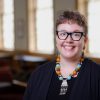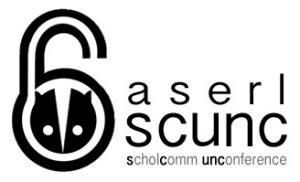This article is more than 5 years old.
Last Thursday, I found myself down in hot, humid Orlando for the first-ever ASERL Scholarly Communication Unconference, aka the ASERL SCUNC (pronounced “skunk”). The day brought together scholcomm folks from across the ASERL region at the John C. Hitt Library at the University of Central Florida. This event had been several years in the making, as it was first proposed by Christine Fruin, Scholarly Communications Librarian at the University of Florida, when she was the Visiting Program Officer for Scholarly Communications for ASERL in 2012-13.
I had never attended an unconference before, so I had little idea of what to expect. The group was small enough that we had time to go around the room and introduce ourselves before determining the schedule for the day and breaking out into sessions. Fortunately for me, there was only one time block when two sessions of interest were competing, and because we were fairly informal, I felt comfortable splitting my time between both sessions.
My first session of the day was on library publishing. As Bill Kane has been representing Wake Forest at most library publishing-specific events, this was an area that I did not know as much about, hence my interest in hearing what other libraries are doing. As was to be expected, the level of engagement ran the gamut, with our Digital Publishing Program—which, admittedly, is not officially under the wing of ZSR, but for all intents and purposes might as well be!—being one of the most robust monograph publishing programs represented. Many ASERL libraries are hosting journals for their faculty and students, but services beyond hosting, e.g. copy-editing and peer review, are generally not being offered. One interesting point of discussion during this session was on whether or not items made available via institutional repositories are considered published or not. I am of the opinion that they are not, although if you look at the OED definition for publish, it means to make public, which is what we do with IRs. But in scholarly terms, publishing usually connotes peer review, editing, and typesetting, which we do not do for items posted in the IR. My hunch is that future expansion in library publishing will need to tackle “IR=publishing?” head on. We also discussed the possibility of libraries publishing items that need to be published, but aren’t of appeal to traditional publishers, e.g. textbooks and datasets. Additionally, library publishing programs typically address preservation, whereas traditional publishers do not; this might be a selling point we can harness to our benefit.
During the second morning time block, I split my time between two sessions. I started with the OER session, to see what other libraries are doing with OERs. Some libraries are supporting OER adoption among faculty through mini-grant programs, an idea Kyle and I have been kicking around since last October’s OA Week presentation by Nicole Allen of SPARC. One challenge with OER mini-grants is distinguishing between adoption/replacement versus creation. An idea that struck a cord was to target new course creation for OER adoption. Here at Wake Forest, I immediately thought about FYS being potential targets. Switching gears, I scooted upstairs to join the session on faculty concerns about copyright. Reassuringly(?!), it sounds like most folks get the same type of questions and concerns about copyright from their faculty that I receive here.
After a fun lunchtime conversation with ASERL colleagues from UVa, Vanderbilt, and Florida, the final session I attended was on faculty concerns about open access. The bulk of this session focused on institutional OA policies, and the challenges around initiating and implementing such policies. There was much discussion about whether or not institutional policies were even appropriate for all institutions, with the consensus being that much depends on institutional culture and high-level administrative support. We also discussed how framing such policies as author rights policies—which is what they are—is more palatable to faculty than calling them OA policies; there is still enough misconception of OA among faculty to cause concern. Another part of our conversation ventured into faculty concerns about OA publishing, and the struggles to get faculty to understand that OA publishing is not unlike traditional publishing, both in terms of prestige and frustrations. No publishing process is without its woes.
The ASERL SCUNC (look below for the awesome logo designed by Ellen Ramsey, UVa!) wrapped up with a session debrief and group discussion. The day was a worthwhile experience, in large part because I was able to put many names and faces together for the first time. Certainly I ran into people I’d met before, but there were several folks with whom I’d traded emails yet had not met in person—it was nice to have an opportunity to do so. I also left with several camping spot recommendations for my family, and an offer to return to Florida to help decorate someone’s house, so I benefited both personally and professionally!


4 Comments on ‘Molly at ASERL SCUNC’
Libraries as publishers! What a concept- I enjoyed your report.
I’m glad you enjoyed hearing more about publishing. also, sometimes acronyms are just unfortunate. They should rethink this one……
Thanks for representing us, Molly.
I like the direction of changing “open access” policies (which might sound like the wild west,) to “author’s rights” policies, which brings control back to the author. It might allow the OA movement to gain better traction among faculty.